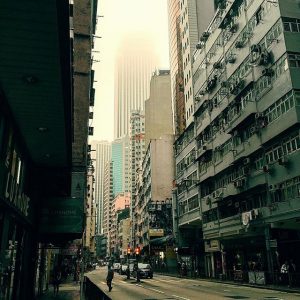Our group here at the City University of Hong Kong is interested in looking at microbial communities in built environments (BEs) of various sorts, including subways and residences. We have recently come up with a review article describing how outdoor and indoor occupants help shape a potential global BE “pan-microbiome,” the microbiome that encompasses BEs around the globe, which is likely to be larger than that of any single BE.
Before I summarise what the review talks about, I just want to say that, where our group is in terms of location puts us in a very unique position to work on this emerging field of indoor microbiology. Let the photo below speak for us:
This is a photo taken minutes from where I live in Hong Kong, and a couple of things pop into my mind. 1) You get a great variation in the types of BEs, from skyscrapers to street-level retail shops and residential units (all with different building and interior designs), positioned in close proximity, 2) this type of urban/city design is very different from those in most other places in the world.
Scientists conducting research works in indoor microbiology know clearly that adjacent outdoor environments and indoor occupants play fundamental roles in shaping the microbiome of the BE (specifically, they act as microbiome sources for the BE). In addition, ventilation and other building design may help facilitate how microbes from the outdoors are introduced into the BE, and occupant activities and lifestyles govern how human-associated microbes are released into their indoor habitats . While their roles are likely to be universal, the nature of the microbiomes in these sources will be different depending on geographical location, due to differences in local terrains, environmental characteristics, and occupant/population lifestyles. For example, microbial communities in the outdoors in the picture above will be different from, say, what is out there in the picture below, taken from my trip a few years ago in Norway.
As a result, it is possible that the BEs from these two pictures will also present much-varied indoor microbiomes, due to its relationship with the immediate outdoor environments:
Comparative analyses from our work as well as others also reveal that the microbiomes on various human sites (skin, gut) also differ by global populations, potentially attributed to variations in physiology, life practices and activities. Therefore, indoor occupants of different areas around the world will release different microbes into their respective BEs.
Taken together, the combined effects of the outdoors, occupants, and how microbiomes of these two sources differ by geographical locations, will contribute to varying microbiomes in BEs of different areas. Therefore, the conglomeration of microbiomes of different BEs around the world will contribute to a global BE pan-microbiome. Therefore, the focus of the review is to describe how universal and location/population-specific factors help shape the BE pan-microbiome. Also, the article also introduces indoor microbiology research before the era of high-throughput sequencing, and potential future outlooks, such as dedication to assessing the viability of detected organisms, and emergence of novel building types (green buildings) around the world, that will help appreciate the magnitude and importance of the pan-microbiome size.
As building design and other factors influence our exposure to microorganisms in BEs, determining a global BE pan-microbiome is important to understand whether our current knowledge is continentally representative. We believe that both universal (e.g. how building designs fundamentally shape BE microbiomes), as well as local factors (local outdoor and occupant microbiome variations, mediated by environmental and anthropogenic properties) govern the microbial communities that are present in a given BE. However, current BE microbiology research works are heavily focused on locations in the western world (with a particular set of outdoor environmental and population/lifestyle characteristics), with much less representation elsewhere. We hope that, through this article, additional BE microbiome research will be focused in other parts of the world, as a more global appreciation of this concept is required to improve the health, comfort, and productivity of indoor occupants on a continental scale.


